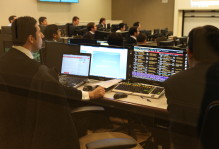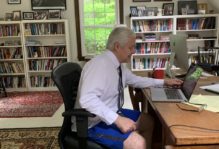What Should Our Students Remember
“Prediction is very difficult, especially about the future.”
It’s been two weeks since we kicked off this year’s university teaching project–two weeks largely filled with the flood of details that need attention to launch the school year. The University Teaching Project brings faculty members to work in small groups to revise one of their courses and to develop a portfolio of their reflections and decisions along the way. The process focuses on common instructional tasks like defining course objectives, tying assessments to objectives and having colleagues visit your class to help develop new perspectives. Every once in a while, though, Dean Schwartz throws in a zinger to keep things interesting.
For me the first zinger came early in the planning process. The question was phrased something like, “if you were to run into a student from the class you’re restructuring 10 years from now, what would you want them to remember about the experience?” Answering that question really requires an act of imagination to envision the kind of world our students will be inhabiting 10 years from now and how their learning today might fit into that world.
 Back in 1693 it seemed safe to assume that the world would be pretty similar only a decade into the future, but that’s certainly not the case today. John Seely Brown, the former Chief Scientist at Xerox PARC, suggests that we consider the impact of the “digital power law” when we try to get a vision of the future. He contends that our access to learning and information will be shaped by the interaction of three technological trends and one human inclination.
Back in 1693 it seemed safe to assume that the world would be pretty similar only a decade into the future, but that’s certainly not the case today. John Seely Brown, the former Chief Scientist at Xerox PARC, suggests that we consider the impact of the “digital power law” when we try to get a vision of the future. He contends that our access to learning and information will be shaped by the interaction of three technological trends and one human inclination.
The trends have been playing out for the last 20 years. The processing power of a desktop computer has doubled roughly every two years, the speed of a network connection has doubled each year, and the amount of storage you can buy for a dollar has doubled each year. These trends will probably slow a bit in light of the recent economic unpleasantness, but it seems unlikely that they’ll stall altogether. Even with moderating growth, in 10 years, we can expect that the average faculty desktop computer:
Will be around 10-30 times faster than today, depending on the ability of the software to catch up with the hardware. (The machines that we are installing now on faculty desktops have about 200 times the processing power of the 486’s from a decade ago.)
Will connect to the network at speeds 10-20 times faster than today. (When we finish the current upgrade, the average desktop will have 100 times the bandwidth it had a decade ago.)
Will come with 10 times more storage and a seamless easy way to back it up. (The average desktop machine today has about 1000 times more storage than a decade ago.)
JSB contends that the overall digital potential of this kind of growth can be estimated as the product of these three growth rates. (His heuristic suggests that our current computer user has 200 X 100 X 1000 times more raw computing power that was available a little more than a decade ago. A decade from now, our average user will have 20 X 20 x 10–about 4000 times more computing potential than is available today–even with conservative estimates.)
If he’s even close to correct, 10 years from now our students will live in a world where their computing devices–however they are configured–will have almost unlimited power to calculate, manipulate text, create and edit audio and video, and to perform tasks that we can’t even imagine right now. What they do with that power may well be shaped by the classes they take as William and Mary undergraduates.
Even though I live with this stuff all day, it’s hard for me to envision how much different that world might be. When I came to William and Mary in April of 1998, Google didn’t exist as a company–that would have to wait until September. Now not a day goes by without multiple trips to Google search, mail, maps, and YouTube. (My own record of predication is actually pretty terrible. I’m still trying to live down telling Courtney that wireless was too low and insecure to ever have any future in higher education). Trying to figure out how our classes today can best prepare our students to use that potential truly is a zinger.
Next time, I’ll write about the human inclinations and how they might might shape the way these trends might impact on higher education.
Related Information
For more thoughts on the future of educational technology, check my personal blog at generoche.net
Source of Quote: Niels Bohr, Danish physicist (1885 – 1962)
More information about JSB and the digital power law is available at CreatingThe21stCentury.org
Photo by http://www.flickr.com/people/adrian_s/




No comments.
Comments are currently closed. Comments are closed on all posts older than one year, and for those in our archive.